New Energy
Biomass Energy Utilization Project of Baicheng City
1 Introduction to the Project
1.1 Project background
1.1.1 Product introduction
Biomass power generation is a thermal electricity production method that utilizes biomass as fuel. This process converts the bio-energy (chemical energy) stored in biomass into thermal energy through combustion, generating high-temperature steam to drive steam turbines which ultimately power electricity generators. Combined Heat and Power (CHP) represents an integrated energy production system. It employs steam generated by boilers to simultaneously provide thermal energy for heating purposes and mechanical energy for power generation. By driving steam turbine generators during the heat supply process, this approach achieves highly efficient co-production of both thermal and electrical energy.
The project relies on the straw resources of Da'an City and surrounding counties and cities to carry out biomass CHP, improve the comprehensive utilization rate of straw, and meet the local power and heating needs.
1.1.2 Market prospect
1 Current development of biomass power generation
(1) The continually growing installed capacity and power generation of biomass power generation in China
Driven by favorable factors such as abundant biomass resource reserves, policy support, and rising social electricity consumption, China's biomass power generation industry is developing towards standardization and marketization, with a continuous increase in installed capacity. Industry statistics reveal that China's biomass power installed capacity has demonstrated consistent growth, increasing from 17.81 GW in 2018 to 44.14 GW in 2023, achieving a CAGR of 16.33%.In parallel with the capacity expansion of biomass power generation, annual electricity generation surged from 90.6 TW·h to 198 TW·h during the same period, corresponding to a CAGR of 13.92%. Compared to wind and photovoltaic power generation, CHP is less affected by natural factors such as climate and can provide sustained and stable energy supply. Especially in the context of increasingly severe global warming, countries around the world have become more stringent on greenhouse gas emissions, and the development and utilization of renewable energy and the improvement of energy efficiency have become the main ways for countries to reduce emissions. The average comprehensive efficiency of traditional fossil fuel power generation systems has been maintained at a relatively low level of 35% to 37% for many years. In contrast, the comprehensive efficiency of CHP systems is much higher than that of traditional fossil fuel power generation systems, with efficiency reaching 60% to 80%. Even the most advanced CHP systems can achieve a comprehensive efficiency of over 90%. In addition to its obvious efficiency advantages, CHP also has value in reducing greenhouse gas emissions, lowering investment in thermal power transmission systems, and enhancing energy supply stability. In the future, under the trend of Carbon Peaking and Carbon Neutrality Goals and energy structure adjustment, biomass power generation in China still has huge development prospects. With the continuous implementation of relevant favorable policies, the improvement of biomass resource utilization rate, and the gradual maturity of business models, the scale of China's biomass power generation industry will further expand.
Figure 1 Cumulative installed capacity and year-on-year growth rate of biomass power generation in China from 2018 to 2023
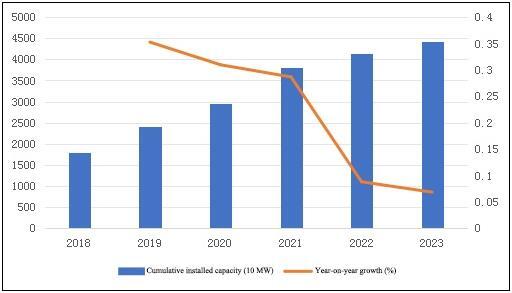
Figure 2 Biomass power generation and year-on-year growth rate in China from 2018 to 2023
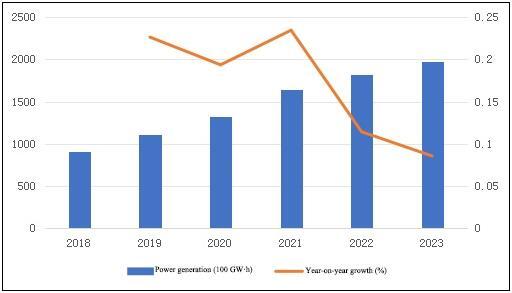
At present, Guangdong Province, Shandong Province, Zhejiang Province, Jiangsu Province, and Anhui Province are the main areas for biomass power generation in China. In the first three quarters of 2023, the power generation in Guangdong Province reaches 17.29 TW·h, the power generation in Shandong Province reaches 14.11 TW·h, the power generation in Zhejiang Province reaches 11.06 TW·h, the power generation in Jiangsu Province reaches 10.57 TW·h, and the power generation in Anhui Province reaches 9.56 TW·h.
Figure 3 Top 5 regions in China for biomass power generation in the first three quarters of 2023
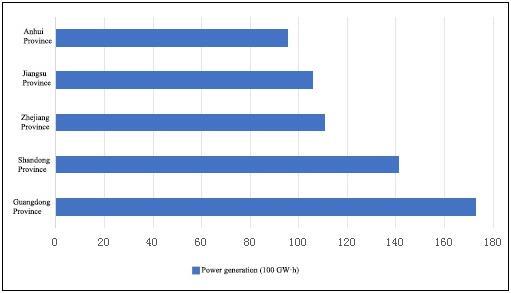
(2) The biomass power generation market mainly based on waste incineration power generation and agricultural and forestry biomass power generation
Biomass power generation mainly includes agricultural and forestry biomass power generation, waste incineration power generation, biogas power generation, etc. In recent years, with the improvement and perfection of China's harmless waste treatment system, the disposal capacity of domestic waste has been continuously strengthened, and the demand for waste incineration has also been increasing. This has led to a continuous increase in the cumulative installed capacity of domestic waste incineration power generation in the biomass power generation market, rising from 50.48% in 2019 to 58.38% in 2023. Agricultural and forestry biomass power generation faces relatively high costs and a relatively single profit model. Therefore, its cumulative installed capacity growth rate is slower than that of waste incineration power generation, and its proportion in the biomass power generation market is showing a downward trend, from 46.39% in 2019 to 38.24% in 2023. While the biogas power generation maintained a minimal share in cumulative installed capacity (≤4%), peaking at 3.38% in 2023.
Figure 4 Cumulative installed capacity proportion of various biomass power generation from 2019 to 2023
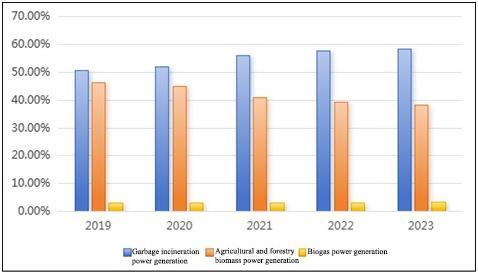
2 Promising biomass CHP
Biomass CHP, as an important development direction in the industry, has received widespread attention from experts, scholars, and research teams in recent years. Compared to the current problems of single profit models and incomplete support policies for pure power generation projects in the agricultural and forestry biomass power generation industry, CHP, as an efficient utilization method, has demonstrated good economic and social benefits and become the main direction of power generation project development. It can meet the heating needs of industrial parks and nearby urban and rural residents according to local conditions.
In the context of national economic development and the Carbon Peaking and Carbon Neutrality Goals, CHP, as an important way of utilizing biomass energy, is playing an important role in supplying low-carbon and clean energy. According to recent comprehensive industry data, there are approximately 3-5 enterprises in China's agricultural and forestry biomass CHP industry that have an annual heating capacity of over 1.5 million tons for individual projects. Whether at the policy level or in actual project investment and construction, the CHP industry is steadily developing. In the future, with the stable growth of the domestic economy, the heat demand for industrial and residential heating will continue to rise. In addition, with the continuous promotion of favorable policies, the development prospects of biomass energy CHP are more promising.
1.1.3 Technical analysis
Biomass conversion is the process of converting biomass into energy that can be used for power generation and heating. The main conversion technologies used for biomass CHP are direct combustion technology and gasification technology. Compared with direct combustion technology, gasification technology has the characteristics of a wide range of gas fuel applications, suitability for processing different types of biomass raw materials, and low emissions, making it a very promising technology. Some studies even suggest that gasification CHP is economically equivalent to traditional coal-fired CHP plants.
1.1.4 Advantageous conditions of project construction
(1) Policy advantageous
The 14th Five Year Plan for the Development of Renewable Energy jointly issued by the NDRC, the NEA and other departments mentions the orderly development of biomass CHP and the acceleration of the transformation and upgrading of biomass power generation to CHP according to local conditions.
The Work Plan for Stable Growth of Light Industry (2023-2024) issued by the MIIT and the NDRC points out the need to increase the proportion and efficiency of CHP, expand the application of biomass energy, and organize the implementation of a number of energy-saving and carbon reduction technology transformation projects.
The Guiding Opinions on Energy Work in 2024 proposes to promote the sustained and positive development of clean heating in northern regions, promote ultra-low emission CHP centralized heating and renewable energy heating such as geothermal, solar, and biomass energy according to local conditions, gradually develop various clean heating methods such as electricity, industrial waste heat, and nuclear energy heating, and promote the safe and orderly implementation of appropriate clean heating projects.
The Notice of the National Energy Administration on Adapting to Local Conditions and Doing a Good Job in Renewable Energy Heating Work clearly proposes to accelerate the transformation and upgrading of biomass power generation to CHP, providing heating for county towns with resources, rural areas with concentrated populations, and small and medium-sized industrial parks. It encourages local governments to actively support biomass energy clean heating projects and create a policy environment conducive to the development of biomass energy heating.
The Notice of the National Energy Administration on Organizing Pilot Demonstrations for the Development of Renewable Energy proposes to support the implementation of clean heating in rural areas with clean heating needs and conditions, through different methods such as biomass CHP and centralized biomass boiler heating according to local conditions, to achieve clean heating in rural areas.
(2) Resource advantageous
Da'an City is an advanced county in grain production in China. The main grain crops of Da'an City are corn and rice, with an annual grain output of 1.73 billion kilograms. The rich straw production of various crops, combined with the straw resources of surrounding counties and cities, provides reliable raw material guarantee for project construction.
Da'an City has 2.1222 million mu of arable land, 665500 mu of forest land, 386700 mu of grassland (artificial grassland, natural grassland), 1.6461 million mu of saline alkali land, and 1.1569 million mu of other grassland and bare land. Da'an City's cultivated land is mainly used for growing grain crops, and it is a world-renowned golden corn belt, a national commodity grain base, and a national grain production line. Da'an City has abundant reserve resources of arable land, with a total area of 1.86 million mu of unused land, accounting for 24.5% of the total area.
The main rivers in Da'an City are Nenjiang River, Tao'er River, and Huolin River. The annual runoff of surface water is 22.2 billion cubic meters; The groundwater resource is 368 million cubic meters, and the groundwater mining output is 280 million cubic meters.
(3) Industrial advantageous
The planned exploitable areas for wind and photovoltaic power in Da'an City are both over 10 GW. Currently, the city's wind power installation and grid connection scale is 1.112 GW, and the photovoltaic installation and grid connection scale is 393.3 MW. On the basis of the existing Western Jilin (Da'an) Clean Energy Chemical Industry Park, a Clean Energy Integration Development Incubation Park has been planned and constructed. By coordinating various investment resources, reasonably allocating projects to enter the park, and gradually introducing a group of industrial enterprises with good development prospects, large investment volume, strong industrial driving force, and excellent comprehensive benefits. Focusing on the development of equipment manufacturing industry, efforts will be made on building incubation parks for the integrated development of clean energy industry.
(4) Talent advantageous
Baicheng City has several colleges and universities, including Baicheng Normal University, Baicheng Medical College, and Baicheng Vocational and Technical College. It is actively introducing Baicheng Industrial Vocational and Technical College. After the college is completed, it plans to recruit more than 2000 undergraduate students annually from Jilin province and the other provinces in China, and reach a scale of 10000 students in 4-5 years. At that time, a "university city" with a total of nearly 50000 teachers and students will be formed together with Baicheng Normal University and Baicheng Medical College, which can provide professional technical talents for the project.
(5) Location advantageous
Da'an City is located at the forefront of opening up to the outside world in western counties and cities of Jilin Province. It is an important link between the innovation and transformation core area of central Jilin Province and the ecological economic zone of western Jilin Province. It is an important node city on the China-Mongolia Grand Corridor (the main railway transportation route of Mongolia Choibalsan-China Arxan-Baicheng-Changchun-Hunchun) and the Hunchun-Ulanhot Grand Corridor.
Railway: There is a national second level marshalling station Da'an North Station, where Changchun-Baicheng Express Railway and Tongliao-Ranghulu Railway intersect. It only takes 1.5 hours to take the high-speed railway to Changchun and 2 hours to reach Ulanhot.
Highway: The Hunchun-Ulanhot Expressway runs through the entire area, reaching 223 kilometers in Changchun City and 282 kilometers in Harbin City. After the opening of Changchun-Baicheng Express Railway and Nenjiang Highway Bridge, it will only take 180 kilometers to Daqing City, connecting the transportation arteries of Jilin Province, Liaoning Province, Heilongjiang Province and Inner Mongolia Autonomous Region in Northeast China.
Waterway: It has a waterway port approved by the State Council for opening to the outside world - Da'an Port. It can be transported downstream along the Nenjiang River to reach Harbin and Port Khabarovsk in Russia, and can also enter the Sea of Japan.
Aviation: There are 6 airports including Changchun, Baicheng, Songyuan, Daqing, Harbin, and Ulanhot surround the area and all of them can be reached within 2 hours, forming a "2-hour economic circle" with Changchun City, Harbin City, and Daqing City.
1.2 Contents and scale of project construction
1.2.1 Scale of project construction
After the completion of the project, it is expected to consume 230000 tons of crop straw annually and generate approximately 200 GW·h of electricity annually.
1.2.2 Contents of project construction
The project covers an area of 90000 square meters and includes the purchase of one 130 ton/hour high-temperature and high-pressure water-cooled vibrating grate boiler, one 30 MW high-temperature and high-pressure extraction condensing steam turbine generator set, and the simultaneous construction of a flue gas purification process system.
1.3 Total investment of the project and capital raising
1.3.1 Total investment of the project
The total investment of the project is 430 million yuan, including a construction investment of 344 million yuan and a working capital of 86 million yuan.

1.3.2 Fundraising
Fundraised independently by the enterprise.
1.4 Financial analysis and social evaluation
1.4.1 Main financial indexes
After the project reaches the production capacity, its annual sales income will be 400 million yuan, its profit will be 60 million yuan, its investment payback period will be 9 years (after the tax, including the construction period of 2 years) and its investment profit rate will be 13.95%.
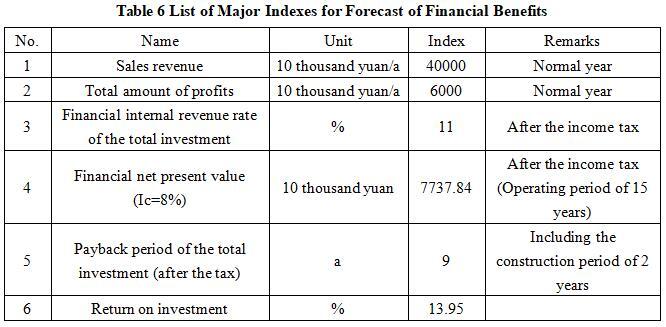
Note: “10 thousand yuan” in the table is in RMB.
1.4.2 Social evaluation
The construction of the project is conducive to accelerating the resource utilization and commercialization of agricultural and forestry waste straw, promoting the optimization and quality improvement of the straw comprehensive utilization industry structure in Da'an City, and promoting the coordinated development of rural economy and society. It is of great significance for promoting clean agricultural production, green development, and ecological environment protection.
1.5 Cooperative way
Joint venture, cooperation, sole proprietorship, other methods can be discussed offline.
1.6 What to be invested by the foreign party
Funds, other methods can be discussed offline.
1.7 Construction site of the project
Da'an City, Baicheng City.
1.8 Progress of the project
This project is in the stage of external investment promotion.
2 Introduction to the Partner
2.1 Basic information
Name: Da'an Key Project Service Center
Address: No. 51 Changbai South Street, Da'an City, Jilin Province
2.2 Overview
Da'an City is located in the northwest of Jilin Province, in the hinterland of the Songnen Plain, and is the highlight of the geographical map of the Chinese rooster. It covers a total area of 4879 square kilometers, governs 18 townships, 10 stations, 5 street offices, and has a provincial-level economic development zone with a total population of 430000. This place has a long history, unique location, abundant resources, and overlapping opportunities, with enormous development potential. It is known as the "Pearl of the Nenjiang River", "Ecological City", "Land of Fish and Rice" and other reputations.
Da'an City takes the construction of Jilin Province's "Ecological Economic Innovation and Development Demonstration Zone" as the center, promotes the value transformation of ecological products, creates an "Ecological Da'an", and strives to build a clean energy production and consumption base, a green agricultural and livestock product production and sales base, and a regional commercial and logistics base. Relying on the advantages of characteristic resources, Da'an City creates a provincial-level comprehensive tourism demonstration city, vigorously promotes rural revitalization, deepens reform and innovation, and strives to build Da'an into a green agriculture development model area in western Jilin, a core area of western clean energy base, an ecological tourism pilot area, and a livable and business friendly waterfront city. Focusing on development positioning, efforts will be made to attract seven types of industrial projects, including chemical industry, clean energy consumption and equipment manufacturing, ecotourism, deep processing of animal husbandry products, deep processing of agricultural and sideline products, deep processing of aquatic products, commercial logistics, and modern services.
2.3 Contact method
Postal code: 131300
Contact person: Wu Dongming
Tel: +86-436-5219233
+86-436-5219277
E-mail: daszsjjhk@163.com
Contact method of the city (prefecture) where the project is located:
Contact person: Xu Zengchun
Tel: +86-436-3203010
+86-13894682986
Fax: +86-436-3224565
E-mail: bcjhj07@126.com


